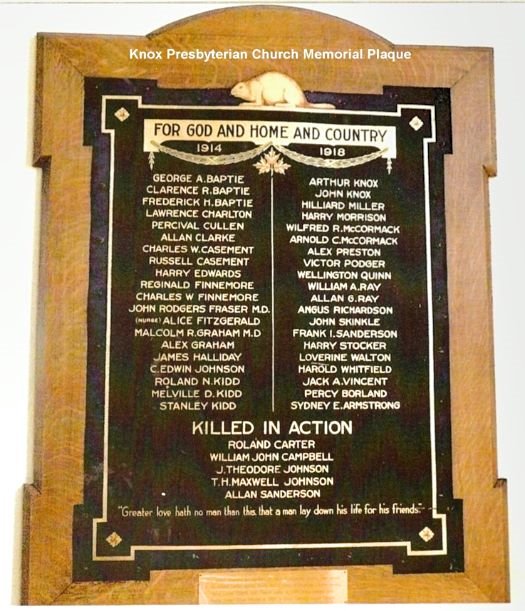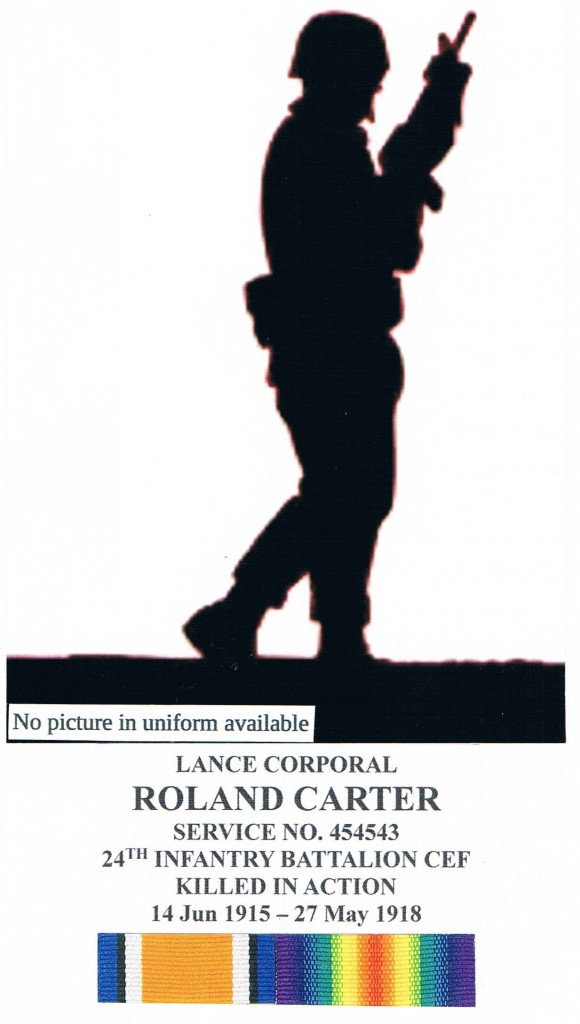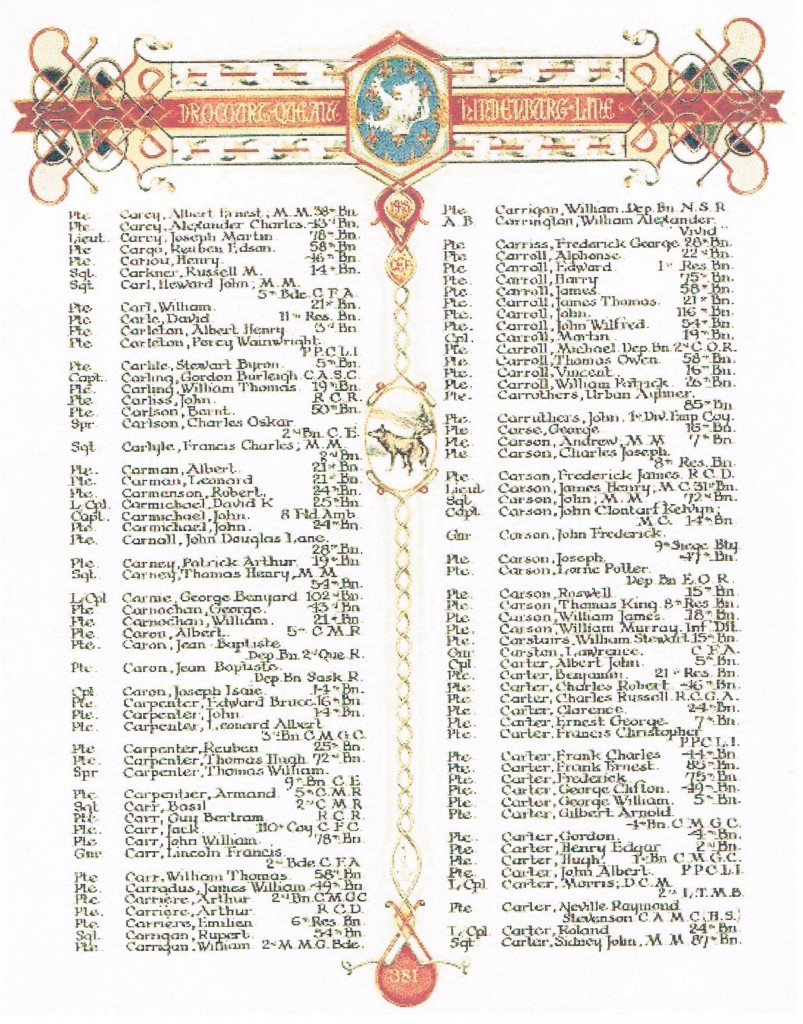MILITARY HISTORY
Lance Corporal Roland Carter – 454543 – ACTIVE SERVICE (World War I)
On June 14, 1915 Roland Carter completed the Attestation Paper for the Canadian Army Overseas Expeditionary Force. He was 31 years and 9 months old when, as a single man, he enlisted for the duration of the War. Roland was born in Lakefield, Ontario and gave his birth-date as September 2, 1883. On his Attestation Paper Roland indicated he did not presently belong to an Active Militia and that he had never served in any Military Force. There is nothing on his File to indicate where he was educated or to what level. He lists Painter as his Trade or Calling. His Medical Examination was conducted in Port Hope, Ontario on June 14, 1915. Roland was 5′ 10” tall, 37” chest (expanded); his weight is not listed. He had a fair complexion, with blue eyes, and dark hair. Medical Records indicate that he had no medical issues and was deemed fit for Overseas duty with the Canadian Army. His next-of-kin was listed as his father, Mr. Robert Carter of Lakefield. Roland signed the Oath and Certificate of Attestation June 14, 1915 in Peterborough, Ontario. The Certificate of Magistrate was signed by the Justice on July 6, 1915. Roland Carter was taken-on-strength, as a Private (Pte), with the 59th Battalion (Bn), Canadian Expeditionary Force (CEF). Pte Carter was assigned Regimental Number 454543.
Pte Carter began his Military Service with the 59th Battalion (Bn) at Barriefield Camp located at Kingston, Ontario on July 6, 1915. Initially the 59th Bn trained at Barriefield Camp before being transported, by train, to Camp Valcartier, Québec where they would complete their Basic Infantry Training. August 15, 1915 Pte Carter was appointed Provisional Corporal. On October 1, 1915, he was appointed Provisional Lance Sergeant. The 59th Bn embarked from Halifax on April 5, 1916 aboard the SS Olympic.
Pte Carter disembarked at Liverpool, England on April 11, 1916 and was transported to Camp Bordon, England, where he was promoted to Provisional Sergeant. On April 26, 1916, he proceeded to the Non-commissioned Officers School (NCOS), located at Camp Bramshott, England. P/Sgt Carter completed the Course on April 29, 1916, and returned to Camp Bordon, on May 1, 1916. June 6, 1916 Pte Carter was struck-off-strength from the 59th Bn on being transferred to the 24th Battalion, 2nd Canadian Division, stationed at Shorncliffe, England. On June 7, 1916 P/Sgt Carter would have embarked from Liverpool, England for France and disembarked the next day. On June 8, 1916, P/Sgt Carter was taken-on-strength with the 24th Bn, in France. On the same day, he ”reverts to ranks” (Private). It was a common practice within the Military, upon being shipped Overseas, for an individual to revert to his permanent rank, dependent on need within the assigned Unit. On July 15, 1916, Pte Carter was promoted to Corporal (Cpl). Based on his own request, on September 3, 1916, he reverts back to the rank of Private.
On September 29, 1916, at Somme, France Pte Carter received gunshot wounds to the left hand, shoulder and back. On September 30, 1916 he was transferred to No 6 General Hospital at Rouen, France. On October 3, 1916 he was transferred to the Canadian Casualty Assembly Centre (CCAC) at Folkestone, England. October 4, 1916 he was evacuated to the 2nd Southern General Hospital, at Bristol, England. On December 5, 1916, upon discharge from the 2nd General Hospital, he was transferred to the Canadian Convalescent Hospital (CCH) at Bearwood Mansion, Wokingham, England. December 19, 1916 Pte Carter was discharged from CCH. On December 23, 1916 he was transferred to the Canadian Convalescent Depot (CCD) at Hastings, England. On February 13, 1917 Pte Carter ceased to be attached to the CCD, Hastings and was taken-on-strength with the 23rd Battalion at Shoreham, England.
April 20, 1917 Pte Carter was struck-off-strength from the 23rd Bn; taken-on-strength with the 24th Bn and returned to France. July 28, 1917 Pte Carter was appointed to Lance Corporal (L/Cpl). August 15, 1917 was the first day of the Battle of Hill 70 at Lens, France; on that day L/Cpl Carter received a gunshot wound to the right upper arm; he was treated at the No 4 Canadian Field Ambulance (CFA). A Field Ambulance was a Mobile Unit of the Medical Corps that was situated close to the Front-Line, and received wounded and sick men. The job of the Field Ambulance personnel was to treat men who could be quickly returned to their Unit, or pass them on for further Medical treatment which was what happened to L/Cpl Carter when he was sent on to the No 6 Casualty Clearing Station (CCS) before being evacuated to the UK for further treatment. On August 18, 1917 there is a note indicating that he was taken-on-strength with the 1st Québec Reserve Depot at Shoreham, England. On August 20, 1917 L/Cpl Carter was admitted to Barrington War Hospital, Shrewsbury, England with what was described as ”a slight wound, fairly clean & healing well”. September 21, 1917 he was transferred to the Canadian Convalescent Hospital (CCH) at Epsom, England and would remain there until October 8, 1917. A discharge note, from the CCH, states: ”Wound not healed on admittance. Is now quite healed. Has been on light duty since admittance & is now fit for duty”. On October 8, 1917, L/Cpl Carter was struck-off-strength from the CCH and taken-on-strength with the 23rd Reserve Battalion. Also on October 8, 1917 there is another reference to the 1st Québec Reserve Depot. On October 27, 1917 L/Cpl Carter prepared a Will stating: ”In the event of my death, I give the whole of my effects to my mother Mrs. Robert Carter, of Lakefield, Ontario”. After being wounded twice, he had probably become a bit fatalistic with regards to his chances of survival. There are no references in his Military File from October 27, 1917, until April 5, 1918.
On April 4, 1918, L/Cpl Carter was struck-off-strength from the 1st Québec Reserve Depot and taken-on-strength with the 24th Battalion (Victoria Rifles). On April 7, 1918 he departed for and joined the No 2 Canadian Corps Reinforcement Camp (CCRC), in France. On April 12, 1918 he departed for and arrived at his Unit, the 24th Bn, on the Front-Line. L/Cpl Carter was killed-in-action, May 27, 1918. His death on this date coincides with the start of the 3rd Battle of Ainse, France. ”At dawn on May 27, 1918 – 4,000 German guns opened fire on a 24 mile long stretch of Allied Lines beginning the 3rd Battle of Ainse. This barrage was followed by a poison gas drop. When the gas settled, 15 German Divisions started the assault on Allied Lines. By the end of the day, (May 27, 1918) the Germans had driven a wedge 40 miles wide, and 15 miles deep through the Allied Lines”. This Battle would rage until June 6, 1918, when the German advance was stopped.
L/Cpl Carter served with the Canadian Army a total of 2 years 11 months and 10 days: 9 months, 2 weeks and 3 days in Canada, 1 year, 5 months and 8 days in the UK, most of which was while he was recovering from wounds incurred in France and 8 months, 2 weeks and 5 days in France.
There is no reference, in L/Cpl Roland Carter’s Military File indicating what Military Medals he was awarded but based on his Military Service, he should have received:
Victory Medal
British War Medal 1914 – 1920
He also qualified for War Service Badge CEF Class “A”.
An excerpt from an article in Maclean’s by Barbara Ameil, September 1996:
The Military is the single calling in the world with job specifications that include a commitment to die for your nation. What could be more honorable.
PERSONAL HISTORY
ROLAND CARTER
Roland Carter was born in Lakefield, Ontario on September 22, 1881 to Robert Carter and Isabella Ann McWilliams.
Roland Carter was a painter by trade when he enlisted with the 54th Battalion C.E.F. in Port Hope on June 15, 1915. Roland Carter became Lance Corporal Roland Carter, Service Number 454543 with the 24th Battalion Canadian Infantry (Québec Regiment). He was killed in action near Arras, France on May 27, 1918, age 36. He is remembered with honour in the Wailly Orchard Cemetery near Pas-de-Calais, France. A group photo which includes him is in Lakefield Historical Society Book “Nelson Falls to Lakefield” (page 163) along with other Lakefield War Veterans.
THE ROLAND CARTER FAMILY OF LAKEFIELD
Roland Carter’s paternal grandparents are William Carter, born 1817 (died 1901) and Mary Watson, born 1821 (died 1883) of Smith Township, Peterborough County and they are buried in the Lakefield Cemetery. They had four children, Robert, Watson, Ann and William Carter. His maternal grandparents were Agnes Rutherford, born 1833 (died 1908) and John Alexander McWilliams, born 1836 (died 1917); both are buried in Little Lake Cemetery, Peterborough, Ontario. They had six children Isabella Ann, Margaret “Maggie” Jane, John Wellington, Adam James, Mary E. and Thomas George Alexander McWilliams.
Roland Carter’s parents; Robert Carter, born May 1, 1854, and Isabella Ann McWilliams, born February 3, 1859 were married on February 18, 1880. Robert was a painter and they made their home in Smith Township where they had three sons Roland Carter born September 2, 1881; Ernest A. Carter born in October 1883 and died June 2, 1885; and Clarence A. born in May 1887 but died December 16, 1889.
Robert Carter died July 4, 1934 and his wife Isabella Ann died May 27, 1936; both are buried in Lakefield Cemetery with their children.
Roland Carter is remembered on a Memorial Plaque that hung in Knox Presbyterian Church which remembers with honour their members who served in the Armed Forces during World War I. This plaque was later moved to the Sanctuary of Lakefield United Church on Regent Street in 1932 after the two churches merged to form Lakefield United Church



